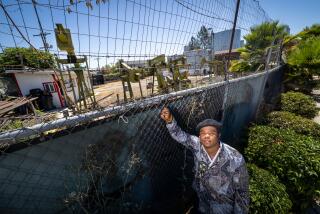Okinawans Bring Drive to L.A.
- Share via
A delegation of women from Okinawa, the scene of one of the bloodiest battles of World War II, are in Southern California to wage a longshot campaign for the dismantling of 42 U.S. military bases they say have disturbed life on their island for more than half a century.
“Fifty-three years is long enough. We have really suffered,” said Suzuyo Takazato, a Naha City assemblywoman, who heads the 13-member Okinawa Women’s Peace Caravan. “The U.S. military presence is deeply rooted in the Okinawan soil, affecting our culture and society.”
The rape of a 12-year-old Okinawan girl by three U.S. servicemen in 1995 prompted the formation of the group, Okinawan Women Act Against Military Violence. They helped draw worldwide attention to the case, bringing 85,000 people to a 1995 rally in Ginowan City.
Their mission now, as the Peace Caravan, is to persuade U.S. officials to remove, reduce or realign the military installations, which they say have turned Okinawa into a de facto U.S. military colony.
Takazato said Okinawans are being treated as third-class citizens by mainland Japan and the United States. Okinawa is the site of 75% of all American military facilities in Japan but has less than 1% of Japan’s land. Okinawans share the island with 27,000 U.S. troops and an additional 23,000 U.S. civilians and military dependents.
“If this burden has to be carried by the Japanese at this time in history, why can’t we share it?” asked Takazato. “Yet, knowing how heavy this burden is, we don’t want other people to carry it. So, what we really want is to eradicate it.”
The delegation, which includes mothers, teachers, community workers and civil servants, leaves Los Angeles on Thursday for Washington, D.C., where its members will tell congressional and State Department officials some of the costs they bear in supporting U.S. military interests.
Since 1972, when the United States returned Okinawa to Japan, there have been 130 aircraft accidents and 154 brush fires caused by military exercises, according to Okinawan government statistics. Twelve Okinawans have been killed by U.S. military personnel.
Harumi Miyagi, a delegate in charge of the Naha City Women’s history project, said that more than 200 Okinawan women and girls have reported being raped by U.S. servicemen since 1972.
The true figure could be much higher, she said, because many woman are too ashamed to report an attack.
An Okinawa government study showed that because of noise, babies born near Kadena Air Base had the lowest birth weight in Japan. A government survey of 933 preschool-age children living in five communities next to military bases found that they caught more colds, had poorer concentration and suffered more emotional problems, headaches and stomachaches than children in other areas.
Students in schools near Kadena Air Base, the biggest military base in Asia, lose an average of two years of their 12-year education because of the constant noise from military planes, said delegation member Fujiko Nakasone, who taught near the base for years.
The base occupies 83% of the land in Kadena, she said, with 14,000 residents jammed in the rest of the city.
“My students used to tell me, ‘If you could compare our town to a beefsteak, the military is the meat and we are the fat trim around it,’ ” she said.
Okinawa, an independent kingdom until Japan annexed it in 1879, was deeded to the United States in 1945 after World War II.
In 1952, the U.S. occupation ended but military control continued until the island reverted to Japan in 1972. While some U.S. bases on Japan’s mainland have closed, military installations on the island remain unchanged.
A Defense Department spokesman said the United States is “very receptive” to and “takes very seriously” the concerns of the people of Okinawa.
“American troops are not in the region for the convenience of the United States,” said Maj. Bryan Salas. “They are in the region because both the U.S. and Japanese governments believe they are an essential element in preserving the security and stability of the Asian Pacific region.”
During their Southern California visit, the women are speaking to city and state officials, college students, community activists and church congregations.
Retired UC San Diego professor Chalmers Johnson, who hosted a brunch for the delegation at his San Diego home Tuesday, said “Okinawa is a ticking time bomb.”
Most Americans know little about the impact of U.S. military installations abroad, he said. Even worse, until worldwide stock prices began to fall, “they didn’t care about the rest of the world,” said Johnson, who now heads the Japan Policy Research Institute, a nonprofit group devoted to the study of Japan and transpacific affairs.
Johnson said Okinawa has been a de facto U.S. colony under an arrangement with the Japanese government that makes Okinawans “even more helpless” than if they had been formally colonized.
“It’s a collusion between Japan and U.S. governments to serve their own interest at the expense of Okinawans,” said Johnson. To have 42 U.S. military bases on an island the size of Puerto Rico, he said, is proof.
The Okinawan group has traveled numerous times to Japan’s mainland to complain. It also is fighting a Japanese proposal to build a sea-based heliport off the waters of Camp Schwab in Nago City, a scenic area at the northern tip of the island.
Military Domain
Okinawa, the southernmost island prefecture of Japan, is home to 42 U.S. military bases. Occupying less than 1% of Japan’s land, Okinawa hosts 75% of all U.S. facilities in Japan.
More to Read
Sign up for Essential California
The most important California stories and recommendations in your inbox every morning.
You may occasionally receive promotional content from the Los Angeles Times.













